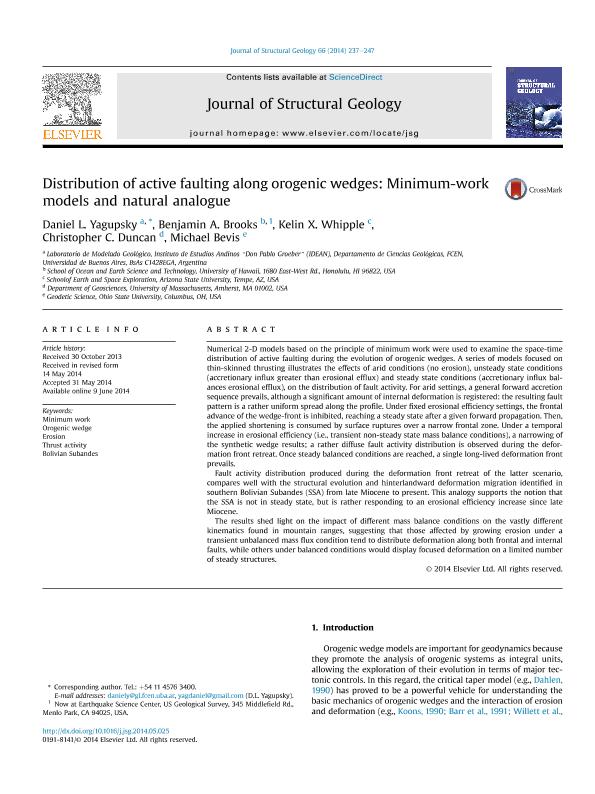Mostrar el registro sencillo del ítem
dc.contributor.author
Yagupsky, Daniel Leonardo

dc.contributor.author
Brooks, Benjamin A.

dc.contributor.author
Whipple, Kelin X.

dc.contributor.author
Duncan, Christopher C.

dc.contributor.author
Bevis, Michael

dc.date.available
2017-06-19T21:44:38Z
dc.date.issued
2014-09
dc.identifier.citation
Yagupsky, Daniel Leonardo; Brooks, Benjamin A.; Whipple, Kelin X.; Duncan, Christopher C.; Bevis, Michael; Distribution of active faulting along orogenic wedges: Minimum-work models and natural analogue; Elsevier; Journal Of Structural Geology; 66; 9-2014; 237-247
dc.identifier.issn
0191-8141
dc.identifier.uri
http://hdl.handle.net/11336/18501
dc.description.abstract
Numerical 2-D models based on the principle of minimum work were used to examine the space-time distribution of active faulting during the evolution of orogenic wedges. A series of models focused on thin-skinned thrusting illustrates the effects of arid conditions (no erosion), unsteady state conditions (accretionary influx greater than erosional efflux) and steady state conditions (accretionary influx balances erosional efflux), on the distribution of fault activity. For arid settings, a general forward accretion sequence prevails, although a significant amount of internal deformation is registered: the resulting fault pattern is a rather uniform spread along the profile. Under fixed erosional efficiency settings, the frontal advance of the wedge-front is inhibited, reaching a steady state after a given forward propagation. Then, the applied shortening is consumed by surface ruptures over a narrow frontal zone. Under a temporal increase in erosional efficiency (i.e., transient non-steady state mass balance conditions), a narrowing of the synthetic wedge results; a rather diffuse fault activity distribution is observed during the deformation front retreat. Once steady balanced conditions are reached, a single long-lived deformation front prevails. Fault activity distribution produced during the deformation front retreat of the latter scenario, compares well with the structural evolution and hinterlandward deformation migration identified in southern Bolivian Subandes (SSA) from late Miocene to present. This analogy supports the notion that the SSA is not in steady state, but is rather responding to an erosional efficiency increase since late Miocene. The results shed light on the impact of different mass balance conditions on the vastly different kinematics found in mountain ranges, suggesting that those affected by growing erosion under a transient unbalanced mass flux condition tend to distribute deformation along both frontal and internal faults, while others under balanced conditions would display focused deformation on a limited number of steady structures.
dc.format
application/pdf
dc.language.iso
eng
dc.publisher
Elsevier

dc.rights
info:eu-repo/semantics/openAccess
dc.rights.uri
https://creativecommons.org/licenses/by-nc-sa/2.5/ar/
dc.subject
Minimum Work
dc.subject
Orogenic Wedge
dc.subject
Erosion
dc.subject
Thrust Activity
dc.subject
Bolivian Subandes
dc.subject.classification
Geología

dc.subject.classification
Ciencias de la Tierra y relacionadas con el Medio Ambiente

dc.subject.classification
CIENCIAS NATURALES Y EXACTAS

dc.title
Distribution of active faulting along orogenic wedges: Minimum-work models and natural analogue
dc.type
info:eu-repo/semantics/article
dc.type
info:ar-repo/semantics/artículo
dc.type
info:eu-repo/semantics/publishedVersion
dc.date.updated
2017-06-19T17:28:26Z
dc.journal.volume
66
dc.journal.pagination
237-247
dc.journal.pais
Países Bajos

dc.journal.ciudad
Amsterdam
dc.description.fil
Fil: Yagupsky, Daniel Leonardo. Consejo Nacional de Investigaciones Científicas y Técnicas. Oficina de Coordinación Administrativa Ciudad Universitaria. Instituto de Estudios Andinos "Don Pablo Groeber". Universidad de Buenos Aires. Facultad de Ciencias Exactas y Naturales. Instituto de Estudios Andinos ; Argentina
dc.description.fil
Fil: Brooks, Benjamin A.. University Of Hawaii At Manoa; Estados Unidos
dc.description.fil
Fil: Whipple, Kelin X.. Arizona State University; Estados Unidos
dc.description.fil
Fil: Duncan, Christopher C.. University Of Massachussets; Estados Unidos
dc.description.fil
Fil: Bevis, Michael. Ohio State University; Estados Unidos
dc.journal.title
Journal Of Structural Geology

dc.relation.alternativeid
info:eu-repo/semantics/altIdentifier/doi/http://dx.doi.org/10.1016/j.jsg.2014.05.025
dc.relation.alternativeid
info:eu-repo/semantics/altIdentifier/url/http://www.sciencedirect.com/science/article/pii/S0191814114001308
Archivos asociados
